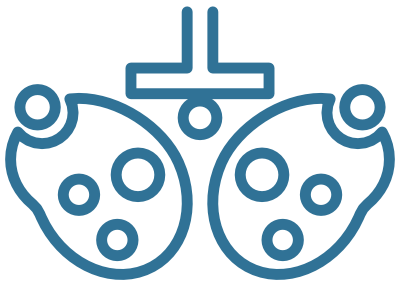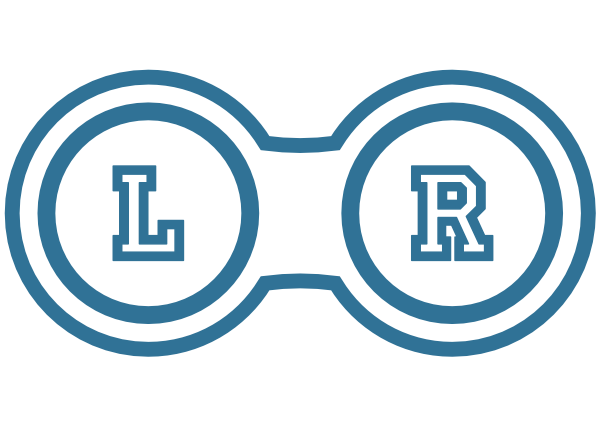There are a few differents tests and procedures that are included when we walk you through our comprehensive eye examination. Each of these has a specific purpose as we take a look at your eyes to examine them and determine their health as well as the clarity and quality of your vision. Some of the tests are quite simple while others are more complex.
Below you will find a list and description of common tests you are likely to encounter during one of our eye exams:
Retinoscopy
When we are looking to determine a prescription for eyeglasses this test is the most common. During a retinoscopy, lights in the room are lowered and a phoropter which is an instrument containing wheels of lenses is positioned directly in front of your eyes. While you are being tested, Dr. Wiarda will ask you to look at an object across the room (usually the big “E” on the wall chart or screen) during which time he will shine a light from a hand-held instrument into your eyes from arm’s length and flip different lenses in front of your eyes.
From the way that the light from the instrument reflects from the lens of your eye, Dr. Wiarda can tell a lot about what your eyeglass prescription should be. Children and people who are not able to speak find that this test is very important and beneficial as they are unable to answer many questions doctors normally ask older patients or verbal patients.
As our world here in Fort Collins, Loveland and Greeley becomes increasingly digitized and many doctors choosing to use automated instruments to help find eyeglass prescriptions today, some doctors choose not to include a retinoscopy in their eye examinations. This test can provide important information regarding the clarity of the internal lens and other media inside the eye. We have seen that doctors who no longer perform this test normally, may still choose to include it when examining someone who might be at risk of cataracts or have other risk factors.
Refraction
Your doctor here in Northern Colorado will use this test specifically to determine your exact eyeglasses prescription. While performing the refraction test, Dr Wiarda will use the phoropter. He will place it in front of your eyes and show you a series of lenses. Dr Wiarda will then ask you which of the two lenses in each choice (“1 or 2,” “A or B,” for example) make the letters on the wall chart look clearer, (they may not be totally clear, but one lens will usually be produce a clearer image than the other). Based upon your answers, Dr. Wiarda will be able to determine the amount of nearsightedness, farsightedness and/or astigmatism your eyes have, and the eyeglass lenses required to correct these vision problems (which are called refractive errors).
Autorefractors and Aberrometers
Sometimes we may also test your eyes with an autorefractor or aberrometer when we are looking to determine your glasses prescription. With both devices, we use a chin rest to stabilize your head while you typically look at a pinpoint of light or other image.
We use an autorefractor to evaluate the way an image is focused on the retina, this is where your vision processing takes place within your eye. With the autorefractor we can do this without the need for you to say anything. Because it is so automated the autorefractor is specifically useful while we examine young children, babies or people who may have difficulty with a regular (“subjective”) refraction. The automated refractions and subjective refractions are usually put to use together during a comprehensive exam to help us find your specific eyeglasses prescription.
An aberrometer uses advanced wavefront technology to detect even obscure vision errors based on the way light travels through your eye.
Cover Test
The cover test is the easiest and the most widely used test for any eye doctor to use to see how your eyes work together.While performing the cover test, your eye doctor will have you focus on a small object at distance and will then cover each of your eyes alternately while you stare at the target. While your eye doctor does this test, he or she will see how much each eye has to move when uncovered to pick up the fixation target. The test is then repeated as you focus on something that is nearer. Cover tests, as simple as they are, can detect very small misalignments that may interfere with your eyes working together the way they should (binocular vision) which can cause amblyopia or “lazy eye.”
Slit-lamp Examination
Dr. Wiarda may use the slit lamp test when determining the health and wellness of your eyes. The slit lamp, also called a biomicroscope, can give us a very magnified view of the structures of the eye, including the lens behind the pupil, so that we can completely examine them for any signs of infection or disease. What is the slit lamp? It is generally an illuminated binocular microscope that is usually mounted on a table and has a chin rest and a headband to position the patient’s head properly and to provide stability during the exam. We also use the slit lamp to examine the retina (the light-sensitive inner lining of the back of the eye) with the help of hand-held lenses.
Tonometry (Glaucoma Testing)
When we test for pressure in the eye itself we use a variety of tests that all fall under the name Tonometry. Some people experience an increase in internal eye pressure which can cause glaucoma. Glaucoma is vision loss because of damage to the sensitive optic nerve in the back of the eye. Generally, the test most doctors use is the “air puff” test – during this test you put your chin on a chin rest and there is a band to hold your forehead in place. Then, an automated instrument discharges a small burst of air onto the surface of your eye. Based on your eye’s resistance to the puff of air, the machine calculates the pressure inside your eye – called your intraocular pressure (IOP).
This test is not the most pleasant of tests and can be a bit startling, nothing but air touches your eye during this test and there is absolutely no risk of eye injury from the air puff test.
Many eye doctors choose another way to measure eye pressure here in Fort Collins, Loveland and Greeley with an instrument called an applanation tonometer. This instrument is usually attached right to a slit lamp. During this test, a yellow eye drop is placed on your eyes. Your eyes will start to feel a little heavy when the drops start working. These drops are not dilating drops – it is simply a numbing agent combined with a yellow dye. We then have you stare straight ahead in the slit lamp while we gently rest the bright-blue glowing probe of the tonometer on the front of each eye and manually measures the intraocular pressure.
Like the air puff test, applanation tonometry is painless and takes just a few seconds.
Since glaucoma is often the result of an increase of pressure inside the eye, these are important tests for ensuring the long-term health of your eyes.
Pupil Dilation
Your comprehensive exam might include the use of dilating eye drops. These are medicated eye drops used to enlarge your pupil so that your we can get a better view of the internal structures in the back of the eye. Dilating drops usually take about 20 minutes to start working. After your pupils have dilated you will find that your eyes are more sensitive to light as there is an increase of light entering your eye. Objects that are near to you may be more difficult to focus on as well. These side effects can last for up to several hours, depending on the strength of the drops used. If you don’t have sunglasses to wear after the exam, disposable sunglasses will be provided to help you drive home. Dilation is very important for people with risk factors for eye disease, because it allows for a more thorough evaluation of the health of the inside of your eyes.
Summary
The above listed tests are the most commonly performed tests in a eye exam. Your specific eye care needs may cause us to decide to include other tests as well or schedule them for another visit. If you would like to schedule an eye exam please contact our office at 970-204-4020 or click on the link on the side of the page.






